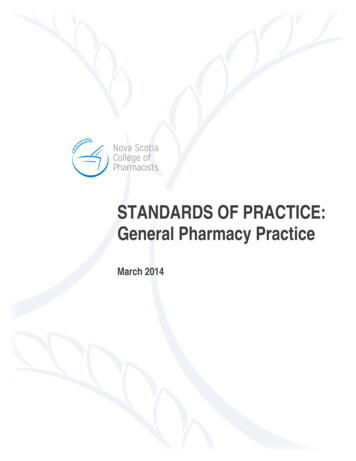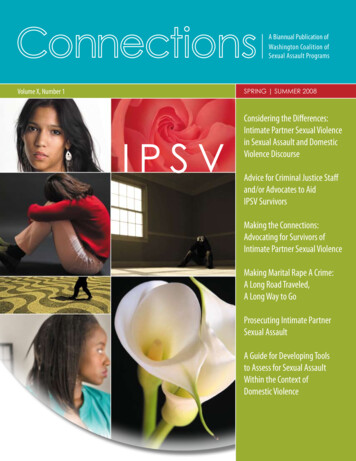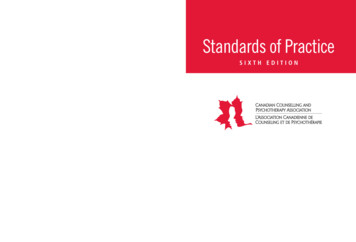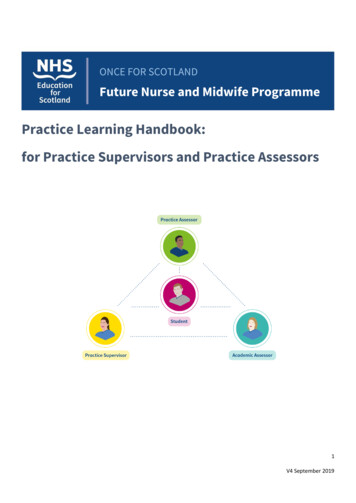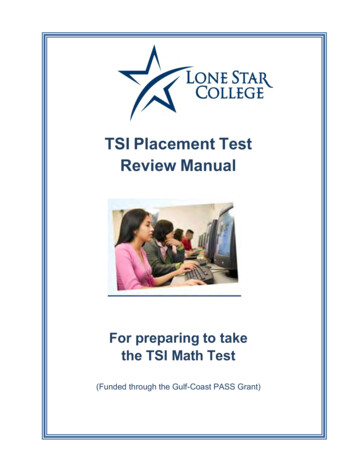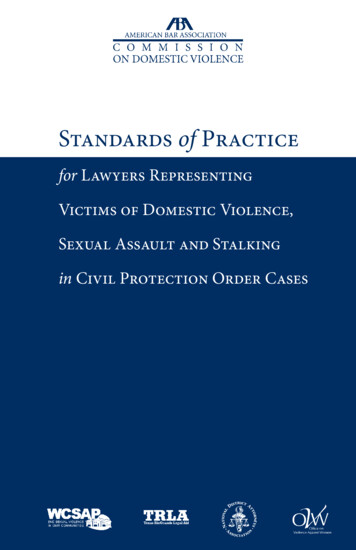
Transcription
Standards of Practicefor Lawyers RepresentingVictims of Domestic Violence,Sexual Assault and Stalkingin Civil Protection Order Cases
Standards of Practicefor Lawyers RepresentingVictims of Domestic Violence,Sexual Assault and Stalkingin Civil Protection Order Cases
This project was supported by Grant No. 2005-WT-AX-K011 awarded by theOffice on Violence Against Women, U.S. Department of Justice. The opinions,findings, conclusions, and recommendations expressed in this documentare those of the author and do not necessarily reflect the views of the U.S.Department of Justice, Office on Violence Against Women.Commentary to these Standards of Practice has not been approved by theHouse of Delegates or Board of Governors of the American Bar Associationand, accordingly, should not be construed as representing the policy of theAmerican Bar Association.Copyright 2007 by the American Bar Association. All rights reserved.ISBN 1-59031-946-X13 DIGIT ISBN: 978-1-59031-946-8For permission to reprint or adapt the contents of this publication,please contact:American Bar AssociationContracts & Copyright750 N. Lake Shore DriveChicago, IL 60611(312) 988-6101copyright@abanet.org
2006-2007ChairHonorable Pamila J. BrownHoward CountyDistrict CourtEllicott City, MDBoard of Governors LiaisonHonorable Laurie D. ZelonCalifornia Courts of AppealLos Angeles, CASpecial AdvisorMargaret B. DrewUniversity of CincinnatiCollege of LawCincinnati, OHCommission MembersDr. Elaine AlpertBoston UniversitySchool of MedicineBoston, MAJulie GoldscheidCUNY School of LawFlushing, NYHonorable Divida GudeAtlanta, GACasey GwinnComprehensive TechnicalAssistance ProgramPresident’s Family JusticeCenter InitiativeSan Diego, CAEsther F. LardentPro Bono Institute at GULCWashington, DCLaurel MooreOffice of the FederalPublic DefenderTampa, FLAllen M. BaileyLaw Office of Allen M. BaileyAnchorage, AKMarjorie A. O’ConnellO’Connell & AssociatesWashington, DCJean CroweLegal Aid Society of MiddleTennessee and the CumberlandsNashville, TNSonia M. RodriguezMorales Rodriguez, PSYakima, WASarah DeerTribal Law and Policy InstituteSt. Paul, MNRichard A. DeMichele, Jr.DeMichele & DeMichele PCCherry Hill, NJLaura V. Farber, Esq.Hahn and Hahn LLPPasadena, CAJay SilvermanDivision of Public Health PracticeHarvard UniversityBoston, MACharles SongCoalition AgainstSlavery & TraffickingLos Angeles, CAJoan ZorzaWashington, DC
ABA Standards of Practicen Standards of Practicefor Lawyers RepresentingVictims of Domestic Violence,Sexual Assault and Stalkingin Civil Protection Order CasesAcknowledgmentsMany people contributed to the development and adoption of theStandards of Practice for Lawyers Representing Victims of DomesticViolence, Sexual Assault and Stalking in Civil Protection Order Cases,and we are deeply indebted to them for their insight, patience,dedication and assistance. Special appreciation is due to ourpartners on the project: Catherine A. Carroll, Washington Coalitionof Sexual Assault Programs; Laura Martinez, Texas RioGrande LegalAid; Jennifer Long, National Center for the Prosecution of ViolenceAgainst Women, American Prosecutors Research Institute, NationalDistrict Attorneys Association; Teresa Scalzo; and Krista BlakeneyMitchell, Office on Violence Against Women, U.S. Departmentof Justice. Funding for the development of these Standards wasgenerously provided by a grant from the Office on Violence AgainstWomen, U.S. Department of Justice.The American Bar Association Commission on Domestic Violencegratefully acknowledges the assistance of the members of theSteering Committee, attendees of the Working Group meetings,Commissioners and Liaisons of the Commission on DomesticViolence, and others who contributed valuable insight and expertiseinto this project:Catherine AlinLegal Assistance Foundation ofMetropolitan ChicagoChicago, ILCherri AllisonFamily Violence Law CenterOakland, CAAllen BaileyLaw Office of Allen M. BaileyAnchorage, AKCarla BeanDallas CountyDistrict Attorney’s OfficeDallas, TX
iinABA Standards of PracticeBronwyn BlakeTexas Advocacy ProjectAustin, TXRichard A. DeMichele, Jr.DeMichele & DeMichele, PCCherry Hill, NJKerry Hyatt BlomquistIndiana Coalition AgainstDomestic ViolenceIndianapolis, INKevin DietzTexas RioGrande Legal AidAustin, TXHedi E. Bogda-ClevelandSouth Dakota Coalition AgainstDomestic Violence andSexual AssaultPierre, SDSandy BromleyMichelle GarciaStalking Resource CenterWashington, DCBrandy DavisJuley FulcherBreak the CycleLos Angeles, CAWashington, DCCandace BridgessKansas Legal ServicesSalina, KSEmberly C. CrossCooperative RestrainingOrder ClinicSan Francisco, CAJean CroweLegal Aid Society ofMiddle Tennesseeand the CumberlandsNashville, TNLeticia CamachoNorthwest Justice ProjectSeattle, WATracy J. DavisErika SussmanCenter for SurvivorAgency and JusticeWashington, DCMark F. DonlonSAFE in HunterdonFlemington, NJMargaret DrewUniversity of CincinnatiCollege of LawCincinnati, OHMonica DriggersGender and Justice ProjectWellesley CollegeWellesley, MABernadette D’SouzaNew Orleans Legal AssistanceNew Orleans, LAChristina EntrekinKelly O’ConnellWashington Coalition ofSexual Assault ProgramsOlympia, WASue FineganMintz, Levin, Cohn, Ferris,Glovsky & Popeo, P.C.Boston, MAJennifer FriedmanSanctuary for FamiliesNew York, NYJanna GobeoKlaus SitteMontana Legal Services Ass’nMissoula, MTDeborah GoelmanDarren MitchellLegal Resource Center onViolence Against WomenTakoma Park, MD
ABA Standards of PracticeM. Timothy GrayOklahoma Coalition AgainstDomestic Violence andSexual AssaultTulsa, OKHon. Divida GudeAtlanta, GALori GuevaraLegal Advocates forIndian CountrySeattle, WABarbara HartSandi MurphyBattered Women’sJustice ProjectMinneapolis, MNKaethe Morris HofferMorris Hoffer Karns, P.C.Chicago, ILSandra JohnsonNational Institute forTrial AdvocacyRaleigh, NCTerry LopezColorado Legal ServicesDenver, COElizabeth MartinWomensLaw.orgBrooklyn, NYPatricia McAllisterVolunteer Legal Servicesof Central TexasAustin, TXRamona NateraLake Worth, FLDana NelsonTravis County DistrictAttorney’s OfficeAustin, TXStephanie NilvaDay OneNew York, NYLeslye OrloffLegal MomentumWashington, DCLisae C. JordanSexual Assault Legal InstituteMaryland Coalition AgainstSexual AssaultSilver Spring, MDSandra S. ParkNew York, NYJinny KimAsian Pacific IslanderLegal OutreachSan Francisco, CALinda PeytonLegal Clinic for the DisabledPhiladelphia, PASusun KimBay Area Legal AidRichmond, CAVicky KimbrellGeorgia Legal ServicesAtlanta, GAPamela KushmaulJohn D. Wheeler & AssociatesAlamogordo, NMGail PendletonASISTADes Moines, IADrucilla RameyNew York, NYJo-Hanna ReadLaw Office of Jo-Hanna ReadSeattle, WAHon. James RiehlPort Orchard, WAElizabeth RourkeEnlace ComunitarioAlbuquerque, NMniii
ivnABA Standards of PracticeJan RussellChicago Police DepartmentChicago, ILSylvia StrussDNA-People’s Legal ServicesFlagstaff, AZRobert SanfordNebraska Domestic ViolenceSexual Assault CoalitionLincoln, NERoberta ValenteNational Council of Juvenileand Family Court JudgesWashington, DCRhonda SaundersLos Angeles DistrictAttorney’s OfficeLos Angeles, CAVictim Rights Law CenterBoston, MALyn M. SchollettIllinois Coalition AgainstSexual AssaultSpringfield, ILMaureen L. White EagleTribal Law and Policy InstituteSt. Paul, MNJoan ZorzaWashington, DCTerra SlavinL.A. Gay and Lesbian CenterLos Angeles, CAWe would like to thank the following ABA staff and entities for their work onthis project: Ellie Banakis, Terry Brooks, Amanda Farnham, Rebecca Henry,Cindy S. Kim, Irena Lieberman, Robin Maher, Linda Rio, Robin Runge,Steve Scudder, Tiffany Tull, Center of Children and the Law, and the CriminalJustice Section.
ABA Standards of Practicen Standards of Practicefor Lawyers RepresentingVictims of Domestic Violence,Sexual Assault and Stalkingin Civil Protection Order CasesPrefaceDomestic violence, sexual assault and stalking are epidemics inour society with dramatic, negative effects on individuals, familiesand communities. These crimes know no economic, racial, ethnic,religious, age or gender limits. Moreover, although these crimes canand do occur independently, they may also occur together, committedby the same perpetrator against the same victim. A sexual assaultvictim may have been stalked prior to the assault; a domestic violencevictim may experience systematic rape in addition to physical andpsychological abuse. Because these crimes may overlap and intersect,it is essential that lawyers providing legal assistance to victims beinformed and educated about them individually and collectively.In order to understand the dynamics of a particular domesticviolence, sexual assault or stalking case, it is important tounderstand the broader continuum of violence in which thesecases occur. By conservative estimates, 1.5 million women in theUnited States are assaulted by their intimate partners every year. Nationally, one in three women will experience sexual violencein her lifetime, and one in twelve women will be stalked in herlifetime. Although women are the victims in the majority of thesecrimes, men are also victims: the same studies reveal that 835,000men are physically assaulted by an intimate partner annually in theUnited States, one in five sexual assault victims are male, and one Patricia Tjaden & Nancy Thoennes, U.S. Dep’t of Just., NCJ 183781, Full Report of the Prevalence, Incidence,and Consequences of Intimate Partner Violence Against Women: Findings from the National Violence AgainstWomen Survey (2000), available at .Patricia Tjaden & Nancy Thoennes, U.S. Dep’t of Justice, NCJ 169592, Stalking in America: Findings fromthe National Violence Against Women Survey, (1998), available at http://www.ojp.usdoj.gov/nij/pubssum/169592.htm
vinABA Standards of Practicein forty-five men is stalked in his lifetime. The need for protectionfrom violence cannot be underestimated.Civil protection orders for victims of domestic violence areavailable in every state. Though states have begun to enact statutesspecifically creating civil protection orders for victims of sexualassault and stalking, only a minority of states have stalking civilprotection orders and fewer still have civil protection ordersavailable for victims of non-intimate partner sexual assault.Civil protection orders are typically issued by state or tribal civilcourts after a showing of abuse or violence or the likelihood ofimminent harm. They may include a variety of provisions thatvary from jurisdiction to jurisdiction requiring, inter alia, thatthe perpetrator (1) stay a certain distance from the victim, (2) notassault or otherwise abuse the victim, and (3) refrain from director indirect contact with the victim. Civil protection orders vary intheir duration (e.g., emergency, temporary or “permanent”), andin many jurisdictions may include remedies such as emergencymonetary assistance, temporary child custody and support, andhousing. Similarly, in every jurisdiction there is an enforcementmechanism whereby the victim may call upon law enforcementto enforce the provisions of the civil protection order when itis violated. In these ways, civil protection orders are intendedto provide tangible, specific protection for victims that haveexperienced domestic violence, sexual assault or stalking.Victims of domestic violence, sexual assault and stalking do notseek protection orders readily, often concerned that the courtwill not believe them and fearing that the abuse will continueeven after the protection order is obtained. Many victims areconcerned about having to face the perpetrator in court, or fearlosing their privacy. In domestic violence cases, the majorityof victims complain of serious physical assault, threats to kill orharm, or attempts or threats to take children. Protection ordersare emergency remedies designed to provide for immediatesafety. Nonetheless, victims of domestic violence, sexual assaultand stalking are regularly murdered by their assailants when they See supra notes 1, 2 and 3.
ABA Standards of Practicenviitry to escape, even after the court has issued a civil protectionorder, demonstrating that these orders can be ineffective withoutenforcement and skilled, holistic advocacy.Access to justice is essential to ensuring that victims of domesticviolence, sexual assault and stalking receive the protection andremedies necessary to prevent and minimize the lifelong, devastatingeffects of these crimes. These Standards recognize the importanceof victims’ full access to the civil protection order remedies availableto them. In addition, lawyers may seek further guidance fromother American Bar Association Standards of Practice for use inconjunction with these Standards: Standards for the Provision of CivilLegal Aid, Standards for Programs Providing Civil Pro Bono LegalServices to Persons of Limited Means and Standards of Practice forLawyers Representing Children in Custody Cases.Use of the StandardsThese Standards are presented as aspirational guidelines for theoperation of legal service providers, pro bono legal service providers,and individual lawyers representing victims of domestic violence,sexual assault and stalking in civil protection order cases. They arebased on the combined and distilled judgment of individuals withsubstantial experience in the area. These Standards do not createany mandatory requirements and failure to comply with a Standardshould not give rise to a cause of action or a finding of a legal ethicsviolation, nor should it create any presumption that an individuallawyer, legal service provider, or pro bono legal service provider hasbreached any legal duty owed to a client or to a funding source.
ABA Standards of PracticenixStandards of Practicefor Lawyers RepresentingVictims of Domestic Violence,Sexual Assault and Stalkingin Civil Protection Order CasesHistoryIn October 2005, with generous funding from the Office onViolence Against Women, U.S. Department of Justice, the Standardsof Practice for Lawyers Representing Victims of Domestic Violence,Sexual Assault and Stalking in Civil Protection Order Cases(“Standards of Practice” or “Standards”) project was launched.Led by the American Bar Association Commission on DomesticViolence and its partner organizations, the Washington Coalitionof Sexual Assault Programs, Texas RioGrande Legal Aid and theNational District Attorneys Association’s National Center for theProsecution of Violence Against Women, the partners developedthese Standards of Practice together.The purpose of the Standards of Practice is to provide a referencetool for practicing lawyers representing victims of domesticviolence, sexual assault and stalking in civil protection ordercases. The Standards of Practice are intended to cover a wide rangeof victim issues that should be considered to provide effectiverepresentation to victims of diverse backgrounds in civil protectionorder cases. The Standards contemplate practice in all U.S. statecourt jurisdictions, but are not intended to be a comprehensiveresource on tribal court practice.The goals of the Standards of Practice are: (1) to improve the qualityof legal representation of victims of domestic violence, sexual assaultand stalking; (2) to enable lawyers to effectively, ethically, andholistically represent victims in civil protection order cases; and (3)to raise awareness about the need for high-quality representationfor victims of domestic violence, sexual assault and stalking in civilprotection order cases.
nABA Standards of PracticeA Standards of Practice Steering Committee met on May 8, 2006in Washington, DC. The Steering Committee was comprised of16 individuals, including practitioners, judges and others withvarious areas of expertise in civil protection orders. With theSteering Committee’s advice, guidance and discussion, a draft of theStandards of Practice was created.To receive substantive and structural feedback on the draft versionof the Standards of Practice, the project partners designed threeWorking Group meetings, gathering lawyers from three geographicregions to maximize diverse input. The first Working Groupmeeting took place on September 18, 2006 in Chicago, IL. Thesecond meeting took place on December 1, 2006 in Seattle, WA, andthe third meeting took place on February 12, 2007 in Austin, TX.All of the Working Group meetings were comprised of approximately10-12 legal practitioners who handle civil protection order casesin various capacities. Through a series of facilitated discussions,dialogue among the meeting participants garnered substantiveand constructive comments which informed the drafting of theStandards of Practice. Finally, the project partners submitted acompleted draft of the Standards of Practice for peer review bypractitioners and national subject matter experts in a series ofconference calls. With this input from “front-line” practitionersand pro bono lawyers, we believe that the Standards of Practice area helpful and practical resource for lawyers representing victims incivil protection order cases.On August 13, 2007, the ABA House of Delegates adopted theblack letter rules and the Preface of the Standards of Practice asofficial policy.It is our hope that these Standards of Practice will not only be aninvaluable resource to lawyers, but will also increase the qualityof legal services to victims of domestic violence, sexual assaultand stalking.
Standards of Practicefor Lawyers RepresentingVictims of Domestic Violence,Sexual Assault and Stalkingin Civil Protection Order CasesTable of ContentsI.PURPOSE & SCOPE . 1II. DEFINITIONS. 1III. ETHICAL DUTIES OF ALL LAWYERSREPRESENTING DOMESTIC VIOLENCE,SEXUAL ASSAULT OR STALKING VICTIMS. 3A.Competent Knowledge of Law . 31. Knowledge of Civil Protection Order Law. 32. Knowledge of Related Legal Issues. 12B.Competent Knowledge ofDomestic Violence, Sexual Assaultand Stalking. 24C. Culturally CompetentRepresentation. 26D. Effective Client Communication. 281. Communication with Clients. 282. Physical Access to Direct Legal Representation. 293. Interpreters and Other Language Resources. 304. Confidentiality and Third Party Privilege Issues. 32
E.Client Safety. 331. Lethality Assessment and Safety Planning. 332. Sensitivity to Effects of Trauma. 34F.Scope of Representation. 351. Client-Centered Representation. 352. Legal Capacity and Duty of Loyalty. 363. Scope of Representation, Case Closing andWithdrawal. 374. Coordination with Allied Professionals; HolisticRepresentation. 38IV. PROCEDURES. 40A.Office Intake Procedures. 40B.Basic Procedural Obligationsof the Lawyer. 41C. Pre-hearing Responsibilities. 44D. Hearings. 54E.Post-hearing Responsibilities. 55
ABA Standards of Practicen I. Purpose & ScopeThe purpose of these Standards of Practice is to providea reference for lawyers representing victims of domesticviolence, sexual assault and stalking in civil protection ordercases, and to encourage lawyers to provide high quality legalrepresentation to those clients. These Standards keep the needsof the client at the center of representation and strive to buildpublic confidence in a just and fair legal system by working topromote safety for victims of domestic violence, sexual assaultand stalking, and accountability for perpetrators.II. DefinitionsA. “Domestic Violence”: Physical abuse, alone orin combination with sexual, economic or emotional abuse,stalking, or other forms of coercive control, by an intimatepartner or household member, often for the purpose ofestablishing and maintaining power and control overthe victim.B. “Sexual Assault”: Any type of non-consensual touchingor sexual penetration, however slight. Sexual assault may beperpetrated by an intimate partner (including a spouse), anon-intimate person known to the victim, or a stranger.C. “Stalking”: A course of conduct directed at aspecific person that would cause a reasonable personto experience fear.D. “Dating Violence”: Physical abuse, alone or incombination with sexual, economic or emotional abuse,stalking, or other forms of coercive control, by a person whois or has been in a romantic or intimate relationship with thevictim, often for the purpose of establishing and maintainingpower and control over the victim.E. “Victim”: A person who has been subjected to domesticviolence, sexual assault and/or stalking. Other terms used todescribe a victim may include “survivor” or “client.”This project was supported by Grant No. 2005-WT-AX-K011 awarded by the Office on Violence Against Women, U.S. Department of Justice.The opinions, findings, conclusions, and recommendations expressed in this document are those of the author and do not necessarily reflectthe views of the U.S. Department of Justice, Office on Violence Against Women. Commentary to these Standards of Practice has not beenapproved by the House of Delegates or Board of Governors of the American Bar Association and, accordingly, should not beconstrued as representing the policy of the American Bar Association.
nABA Standards of PracticeF. “Perpetrator”: A person who commits an act ofdomestic violence, sexual assault and/or stalking againsta victim. Other terms used to describe a perpetrator mayinclude “offender,” “batterer,” “abuser,” or “assailant.”G. “Client”: Any person receiving the services of a lawyer.In these Standards, the person receiving services is avictim of domestic violence, sexual assault and/or stalkingwho is petitioning the court for a civil protection order, oris the person seeking the civil protection order on behalfof the victim.H. “Respondent”: Any person responding to a petition fora civil protection order. In these Standards, a respondent is aperson alleged to have committed an act or acts of domesticviolence, sexual assault and/or stalking and against whom thecivil protection order is sought. Other terms used to describethe respondent may include “defendant,” “perpetrator,”“offender,” “batterer,” “abuser” or “assailant.”I. “Federally Recognized Tribe”: A group, band,nation or other organized group of indigenous Americanpeople, including any Alaska Native village, which isrecognized by the federal government as constituting adistinct and historically continuous political entity.J. “Civil Protection Order”: A civil court order,enforceable by law enforcement, intended to protect a victimand to stop the violent, dangerous and/or harassing behaviorof a respondent. A civil protection order, if violated, cansubject the respondent to criminal prosecution. Other termsused to describe a civil protection order may include “orderfor protection,” “restraining order,” or “peace order”; however,in some jurisdictions these terms may have a distinct meaningand usage, and may not be enforceable by law enforcement.K. “Safety Plan”: An individualized set of strategiesdesigned to maximize the safety of a victim who may be indanger of further harm from a perpetrator.This project was supported by Grant No. 2005-WT-AX-K011 awarded by the Office on Violence Against Women, U.S. Department of Justice.The opinions, findings, conclusions, and recommendations expressed in this document are those of the author and do not necessarily reflectthe views of the U.S. Department of Justice, Office on Violence Against Women. Commentary to these Standards of Practice has not beenapproved by the House of Delegates or Board of Governors of the American Bar Association and, accordingly, should not beconstrued as representing the policy of the American Bar Association.
ABA Standards of Practicen L. “Lethality Assessment”: An assessment, typicallyvia a screening instrument, designed to gauge the future riskof homicide to the victim by the perpetrator of domesticviolence, sexual assault and/or stalking.M. “Full Faith and Credit”: A constitutionallyand/or legislatively mandated rule of law requiring eachstate, federally recognized tribe or territory to recognizeand enforce some or all public acts, records, and judicialproceedings of every other state, tribe and territory. TheViolence Against Women Act 2005 (VAWA) mandates thatevery state, recognized tribe and territory provide full faithand credit to protection orders issued by other states, tribesor territories. This includes provisions in protection ordersrelating to custody, visitation and support. For the purposesof full faith and credit under VAWA, a protection order is anyinjunction, protection order, restraining or other order issuedfor the protection of victims of domestic violence, sexualassault, dating violence or stalking.III. Ethical Duties of All Lawyers RepresentingDomestic Violence, Sexual Assault orStalking VictimsLawyers are bound by their jurisdiction’s ethics rules in allmatters. In order to most effectively discharge their ethicalobligations, lawyers representing victims of domestic violence,sexual assault and stalking should comply with the standardsof practice identified here.A.Competent Knowledge of Law1. Knowledge of Civil ProtectionOrder LawBefore representing a client in a civil protectionorder case, the lawyer should have competentknowledge of the civil protection order laws in therelevant jurisdiction(s).This project was supported by Grant No. 2005-WT-AX-K011 awarded by the Office on Violence Against Women, U.S. Department of Justice.The opinions, findings, conclusions, and recommendations expressed in this document are those of the author and do not necessarily reflectthe views of the U.S. Department of Justice, Office on Violence Against Women. Commentary to these Standards of Practice has not beenapproved by the House of Delegates or Board of Governors of the American Bar Association and, accordingly, should not beconstrued as representing the policy of the American Bar Association.
nABA Standards of PracticeCommentaryCompetent knowledge means, at a minimum, basiclitigation skills, an understanding of the burden of proof,knowledge of the requirements to obtain a protectionorder and remedies available to victims under the statutesof their particular jurisdiction.All jurisdictions in the U.S. allow for civil protection ordersfor victims of domestic violence, while only a minority ofjurisdictions allows civil protection orders specifically fornon-intimate partner sexual assault and stalking victims.These orders can have various application or eligibilityrequirements, and may provide different forms of relief todifferent affected parties.Domestic ViolenceEvery jurisdiction has relationship requirements thatmust be met in order for a victim to be eligible fora domestic violence civil protection order. In mostjurisdictions, a victim must be married or formerlymarried to, be living with or have lived with be relatedby blood to, or have a child with the perpetrator. Thevictim need not be separated from the perpetrator toqualify. However, the relationship requirement variesby jurisdiction and some allow other relationshipsto qualify. For example, some jurisdictions allow forprotection orders for teens or for those in non-sexualdating relationships. In some tribal jurisdictions broaderrelationship requirements may exist.Anti-harassment protection orders may also be usedto protect victims who do not meet the eligibilityrequirements for domestic violence protection orders,such as elders who are abused by non-family members,clients with disabilities who are abused by personalcare attendants, or teens who are victimized bysomeone with whom they do not have an intimate orsexual relationship.This project was supported by Grant No. 2005-WT-AX-K011 awarded by the Office on Violence Against Women, U.S. Department of Justice.The opinions, findings, conclusions, and recommendations expressed in this document are those of the author and do not necessarily reflectthe views of the U.S. Department of Justice, Office on Violence Against Women. Commentary to these Standards of Practice has not beenapproved by the House of Delegates or Board of Governors of the American Bar Association and, accordingly, should not beconstrued as representing the policy of the American Bar Association.
ABA Standards of Practicen Not only is domestic violence physical, sexual,economic or emotional abuse, it is also the inflictionof fear of imminent harm to a person. The threat ofimminent harm is measured from the perspective ofthe victim. Perpetrators often threaten to take minorchildren away from victims, and victims are oftentold that they will never see their children again ifthey pursue legal action against the perpetrator. Itis important for the lawyer to make clients aware oftheir rights and the best interest standards regardingchild custody, visitation and child support in theirjurisdiction. The lawyer should also be aware ofremedies to seek when a child has been abducted and isin immediate harm by being with the perpetrator (i.e.,how to obtain a writ of attachment for the immediatereturn of the minor child and language to include in thefinal protection order to prevent parental abduction).When a domestic violence civil protection order is issuedby a court, the order may include specific remedies. Inevery jurisdict
Texas RioGrande Legal Aid Austin, TX Mark F. Donlon SAFE in Hunterdon Flemington, NJ Margaret Drew University of Cincinnati College of Law Cincinnati, OH Monica Driggers Gender and Justice Project Wellesley College Wellesley, MA Bernadette D'Souza New Orleans Legal Assistance New Orleans, LA Christina Entrekin Kelly O'Connell

